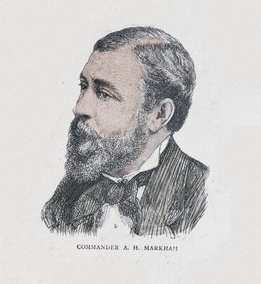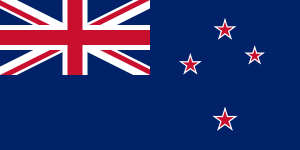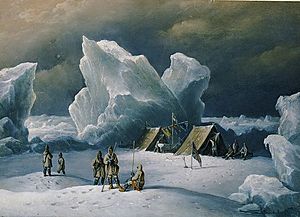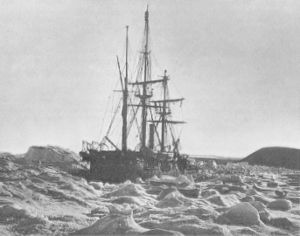Albert Hastings Markham facts for kids
Quick facts for kids
Sir Albert Markham
|
|
|---|---|

Albert Hastings Markham in 1876
|
|
| Birth name | Albert Hastings Markham |
| Born | 11 November 1841 Bagnères-de-Bigorre, France |
| Died | 28 October 1918 (aged 76) London, England |
| Allegiance | |
| Years of service | 1856–1906 |
| Rank | Admiral |
| Unit |
|
| Commands held |
|
| Battles/wars | Nukapu Expedition |
| Awards | ADC KCB (1903) |
| Relations | Father: Captain John Markham Mother: Marianne Markham (née Wood) Wife: Theodora Markham (née Gervers) Cousin: Sir Clements Robert Markham KCB FRS |
| Other work | Arctic Exploration Council of the Royal Geographical Society Author |
Sir Albert Hastings Markham (born November 11, 1841 – died October 28, 1918) was a British explorer, writer, and officer in the Royal Navy. He was known for his adventures in the Arctic and for helping design the flag of New Zealand. In 1903, he received a special honor, becoming a Knight Commander of the Order of the Bath.
Contents
Early Life and Family
Albert Markham was born in Bagnères-de-Bigorre, France. His father, Captain John Markham, had been in the navy but retired early due to poor health. Albert's grandfather, William Markham, was once the Archbishop of York. Albert was also a cousin and close friend of Sir Clements Markham, who was also a famous geographer and explorer.
When Albert was 13, he moved to London to live with his aunt and uncle. Their neighbors included the famous explorer Vice-Admiral Robert FitzRoy and the writer William Thackeray. Albert was mostly taught at home and later attended Eastman's Royal Naval Academy. His father struggled to pay for his education. Luckily, the navy started accepting slightly older students, which allowed Albert to join.
Albert's cousin, Clements, was 11 years older and had also joined the navy before becoming an explorer. Clements became a lifelong friend and greatly influenced Albert's career. Albert was a very disciplined person. He didn't smoke or drink, and he found it hard to relax with other officers. He preferred the challenges of navy life over social events.
Albert's family later moved to a farm in Wisconsin, in the United States. Albert visited them twice but wasn't very impressed with the travel. However, he loved the wild beauty and wildlife of the Mississippi Valley. He enjoyed hunting throughout his life. The only hunting he disliked was the long, painful deaths of whales he saw during his Arctic trips.
In 1894, Albert married Theodora Gervers, and they had one daughter.

Albert Markham joined the Royal Navy in 1856 when he was 15 years old. Even though he often got seasick and disliked the harsh punishments common in the navy, he stuck with it. He saw the navy as a way to pursue his other interests, like exploration.
For his first eight years, he served on the China Station. He sailed on several ships, including HMS Camilla and HMS Niger. During this time, Chinese pirates were a big problem. Once, at just 15, Albert led a small group against a pirate ship. The pirates fled, and those caught were punished. Another time, he commanded a small boat with a cannon against a pirate ship holding two British prisoners. After a long fight, he boarded the ship and rescued the prisoners. He also developed an interest in birds during this time.
In 1862, Albert was promoted to lieutenant. He returned to Britain in 1864 and stayed with his cousin Clements. He was then assigned to HMS Victoria in the Mediterranean. Life here was less dangerous, and he had time to visit many historical places like Turkey, Egypt, and Greece. He kept a journal of his travels, which he did throughout his life.
In 1868, Markham was assigned to HMS Blanche in Australia. Here, he helped stop the illegal trade of people from the South Sea Islands, sometimes called "blackbirding." This was a complex issue, as some islanders were willing to travel for work, while others were forced. After a bishop and three others were killed in one incident, Markham led a group to Nukapu. He destroyed a local village in response. While some criticized his actions, the navy approved. Markham felt this work was more important than his time in the Mediterranean.
In 1869, he created a design for a national flag for New Zealand. His design, which included the Southern Cross stars, was approved and is still used today.
He was promoted to commander in 1872 and spent the next six years exploring the Arctic. For his efforts in the British Arctic Expedition of 1876, he was promoted to captain. He later commanded HMS Triumph in the Pacific and HMS Vernon, a naval torpedo school. From 1886 to 1889, he led the navy's training squadron. In 1891, he became a rear-admiral.
The Sinking of HMS Victoria
In 1892, Markham became second-in-command of the Mediterranean fleet. On June 22, 1893, during a training exercise, the fleet's commander, Admiral Sir George Tryon, gave a strange order. He told two columns of ships, including Markham's ship HMS Camperdown, to turn towards each other. The ships were too close for this turn to be safe.
Markham hesitated, but eventually followed the order. Tryon's flagship, HMS Victoria, turned very sharply. Markham's ship, HMS Camperdown, turned slower but still collided with Victoria. Victoria sank in just 15 minutes, and 358 men, including Admiral Tryon, were lost.
The crew of Victoria were cleared of blame. Markham was not put on trial, but the navy noted that it was difficult to blame an officer for following a direct order, even if it seemed risky. Markham wanted his own trial to clear his name, but he was advised not to.
After this, Markham spent some time without a command. He was promoted to Vice-Admiral in 1897. In 1901, he became Commander-in-Chief at the Nore, responsible for defending the port of London. He became a full admiral in 1903 and retired in 1906. When World War I began, he offered to help the navy, but his offer was declined. Instead, he worked for a fund that helped mine sweepers. He passed away in 1918, just before his 77th birthday.
Adventures and Exploration
In 1873, Markham sailed on a whaling ship called Arctic through the Davis Straits and Baffin Bay. He wrote detailed notes about the ice conditions and suggested routes for steamships.
For the British Arctic Expedition of 1875–76, he was second-in-command of HMS Alert. Despite facing challenges like scurvy (a disease caused by lack of vitamin C) and poor clothing, he led a sled team to the highest latitude ever reached at that time (83°20′26″ N). This record stood for 20 years. They aimed to reach the North Pole but didn't quite make it.
In 1879, he traveled to Novaya Zemlya, a remote island in northern Russia. In 1886, he went alone to study the ice in Hudson Strait and Hudson Bay in Canada. His report was highly praised by the Canadian Parliament. The ship he used for this trip was his old ship, Alert.
Markham served for many years on the Council of the Royal Geographical Society with his cousin, Sir Clements Markham. He strongly supported both Arctic and Antarctic exploration and was happy to see young explorers succeed.
His Writings
Markham wrote many books and articles about his explorations. He also wrote two biographies (life stories) of other people. While in the Pacific from 1879 to 1882, he made a list of Pacific gulls. A bird called Markham's storm petrel was named after him because of his contributions to science.
Some of his books include:
- The Cruise of the 'Rosario' Amongst the New Hebrides and Santa Cruz Islands (1873)
- A Whaling Cruise to Baffin's Bay and the Gulf of Boothia (1874)
- The Great Frozen Sea (1880)
- A Polar Reconnaissance: Being the Voyage of the 'Isbjörn' to Novaya Zemlya in 1879 (1881)
- Life of Sir John Franklin and the North-west Passage (1891)
- The Life of Sir Clements R. Markham, K.C.B., F.R.S (1917)
Birds Named by or After Markham
Places Named After Him

Several places are named after Sir Albert Hastings Markham:
- Markgama Island in Russia.
- Cape Alberta Markgama, a cape on Hooker Island.
- Markham Channel.
- Markham Ice Shelf, a former ice shelf on Ellesmere Island in the Canadian Arctic.
- Mount Albert Markham in Antarctica.
Images for kids



